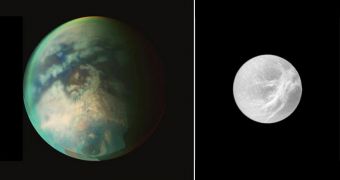Experts at the NASA Jet Propulsion Laboratory (JPL), in Pasadena, California, announce that the Cassini spacecraft will perform this week consecutive flybys of two Saturnine moons. The science team at the lab explains that a fortuitous cosmic alignment will allow the probe, which has been orbiting Saturn since July 2004, to pass by the two space rocks within less than a day and a half, without having to perform any additional maneuvers in between. The two bodies targeted are the moons Titan and Dione.
The former has been heavily scrutinized by both the Cassini orbiter and the European Space Agency's (ESA) Huygens lander, which touched down on its surface on January 14, 2005. Since then, it was discovered that the polar regions of the gas-enveloped moon are laden with lakes of liquid hydrocarbons, most probably methane and ethane. There is a distinct possibility that some forms of life may exist on this moon, experts say, and Cassini is constantly swinging by it, trying to collect more data. The new flyby is dubbed T67, the JPL team says.
On the other hand, the moon Dione has been a lot less scrutinized, and getting the chance to visit it is one of the main reasons why the Cassini mission received its extension. The flyby around this cosmic object will take place tomorrow, April 7, at a distance of only 500 kilometers (300 miles). This is the second meet-up between the explorer and the moon, the first one taking place in October 2005. The main goal of the study will be to see whether Dione indeed expels plumes of matter from its surface into one of the Saturnine rings, as preliminary data would seem to indicate.
Thus far, Cassini only performed three double flybys, when the correct alignments allowed for this. Two more are scheduled to take place later in the year. Also, this October, the first extension of the orbiter's mission, known as Equinox, will end, and the second one (the Solstice mission) will begin. The Cassini-Huygens mission is a cooperative project of NASA, ESA and the Italian Space Agency. The Jet Propulsion Laboratory, a division of the California Institute of Technology in Pasadena, manages the Cassini-Huygens mission for NASA's Science Mission Directorate in Washington, DC. The Cassini orbiter was designed, developed and assembled at JPL.

 14 DAY TRIAL //
14 DAY TRIAL //